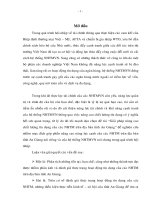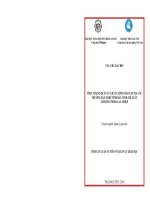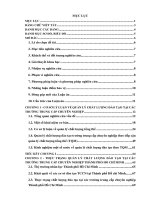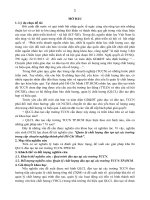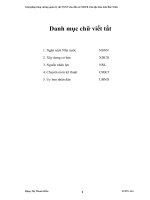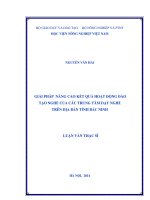Thực trạng quản lý chất lượng đào tạo của các trường dạy nghề trên địa bàn tỉnh Bắc Ninh Đề xuất chương trình can thiệp
Bạn đang xem bản rút gọn của tài liệu. Xem và tải ngay bản đầy đủ của tài liệu tại đây (827.48 KB, 82 trang )
ThAi nguyen University Southern luzon STATE University
Socialist Republic of Vietnam Republic of Philippines
____________________________________________________________________________
DISSERTATION
STATUS OF TRAINING QUALITY MANAGEMENT OF VOCATIONAL
SCHOOLS IN BAC NINH PROVINCE: A PROPOSED
INTERVENTION PROGRAM
Advisor : DR. RICARYL CATHERINE P. CRUZ
Name of Student : CHU BA CHIN
English Name : NINE
Date of Birth : 16-1-1970
Course : SLSU-DMEd
Thai Nguyen, Apr 2014
ii
STATUS OF TRAINING QUALITY MANAGEMENT OF VOCATIONAL
SCHOOLS IN BAC NINH PROVINCE: A PROPOSED
INTERVENTION PROGRAM
A Dissertation Presented to
the Faculty of the Graduate School
Southern Luzon State University, Lucban, Quezon, Philippines
in Collaboration with
Thai Nguyen University, Socialist Republic of Vietnam
In Partial Fulfillment of the
Requirements for the Degree of
Doctor of Philosophy in Educational Management
Chu Ba Chin - ( Nine )
April, 2014
iii
APPROVAL SHEET
In partial fulfillment of the requirements for the degree Doctor of philosophy in
Educational Management, this research entitled “Status of the Training Quality Management
of the Vocational Schools in Bac Ninh Province: A Basis for a Proposed Intervention
Program” has been submitted by Chu Ba Chin - Nine, and is hereby recommended for oral
examination.
DR. RICARYL CATHERINE P. CRUZ
Research Adviser
Approved by the Oral Examination Committee, in partial fulfillment of the requirements
for the degree Doctor of Philosophy in Educational Management offered by Southern Luzon
State University, Republic of the Philippines in collaboration with Thai Nguyen University,
Socialist Republic of Vietnam.
DR. ……………………
Member
DR………………………….
Member
DR…………………………
Member
DR. ………………………
Member
DR. ………………………… SUSANA A. SALVACION, Ph.D.
Chairman Dean, Graduate School
Accepted in partial fulfillment of the requirements for the degree Doctor of Philosophy in
Educational Management offered by Southern Luzon State University, Republic of the
Philippines in collaboration with Thai Nguyen University, Socialist Republic of Vietnam.
WALBERTO A. MACARAAN, Ed .D
Vice President, Academic Affairs
Date___________________ .
iv
ACKNOWLEDGMENT
Completion of this doctoral dissertation was possible with the great support of the
following teachers, schools and individuals to whom the researcher would like to express his
special thanks:
Dr. Cecilia N. Gascon, President of the Southern Luzon State University, Republic of
the Philippines for permission of training for Doctor of Philosophy in EducationalManagement
in International training center, Thai Nguyen University;
Dr. Dang Kim Vui, President of Thai Nguyen University for allowance the training for
Doctor of Philosophy in Educational Management in International training center, Thai Nguyen
University;
Dr. Ricaryl Catherine P. Cruz, lecturer of Southern Luzon State University, Philippines
Republic for enthusiastically instruction in the completion of this research;
Dr Apolonia A. Espinosa and Dr. Teresita V. Dela Cruz, for their suggestions and
recommendations;
Dr. Tran Thanh Van, Head of Postgraduate, Thai Nguyen University and Dr. Dang
Xuan Binh, Director of International Training Center for their kind support throughout the
course of this study;
Rector of the Vocational Schools in Bac Ninh Province, especially Master Nguyen
Hong Nam, rector of Bac Ninh Vocational College of Construction and Engineering for his
contribution in the survey questionnaire to enrich the database for my study;
Managers, lecturers, teachers and individuals for their participation in answering the
questionnaire in the survey of this research;
v
The researchers’ family, his loved ones for encouraging him at every phase of the
research, giving him the determination to go through the most difficult stages of the research.
CBC
vi
DEDICATION
This research could not be completed without the precious supports, helps and
encouragement from those people below who I would like to send my special thanks. First of all,
I would like to express my thankfulness to my tutor for the continuous support from initial
advice and contacts in the early stages of conceptual inception and through ongoing advice and
encouragement to this day.
A special thank of mine goes to my friends in Bac Ninh Vocational College of
Electromechanical and Construction, Bac Ninh Vocational College of Economic Technical
School, Vocational College of Management – Technology School, Vilacera Vocational
College, Bac Ninh Economic Technical Vocational Middle School, Au Lac Vocational Middle
School, Thuan Thanh Vocational Middle School, Đong Duong International Vocational Middle
School, Thuan Thanh Vocational Middle School of Economics - Engineering and Traditional
Handicrafts, Vocational Middle School - the Department of Defense for giving me permission to
commence this thesis from the initial stage to the end, to do the necessary research work and to
use current status of training quality management and data of the schools for my analyses. I also
want to thank all respondents for helping me to carry the survey of questionnaire in order to
collect the primary data which is necessary for data analysis.
My particular thank goes to my classmates and the teachers of this course in helping me
to expand my knowledge in the topic in my thesis. This program really brought us together to
appreciate the true value of friendship and respect of each other.
I wish to thank my family for their precious support during my working. The last but not
the least I want to thank my wife who patiently love and enabled me to complete this thesis in
time.
vii
TABLE OF CONTENTS
TITLE PAGE i
APPROVAL SHEET iii
ACKNOWLEDGMENT iv
DEDICATION vi
TABLE OF CONTENTS vii
LIST OF TABLES ix
LIST OF FIGURES x
ABSTRACT xi
Chapter I INTRODUCTION 1
Background of the Study 2
Objectives of the Study 3
Significance of the study 5
Scope and limitation of the study 5
Definition of terms 5
Chapter II REVIEW OF LITERATURE AND STUDIES 8
Training and Training Quality in Vocational Education 8
Goals and tasks 9
Organisation and management 10
Teaching and learning activities 13
Teachers and administrators 14
Curriculum and Syllabus or Academic Aspect 14
Facilities and equipment 15
Financial management 15
Services for students 18
Conceptual Framework 19
Research Paradigm 21
Discussion of the Paradigm 21
Chapter III METHODOLOGY 23
Locale of the Study 23
Research Design 23
Population and Sampling 24
Research Instrument 25
Validation of instrument 25
Data Gathering Procedures 26
Statistical treatment 27
RESULTS AND DISSCUSSIONS 30
Determining the Status of the Training Quality Management of Vocational Schools 30
viii
Diversity of Vocational Schools in terms of Goals and Task, Organization and Management,
Teaching and Learning Activities, Teachers and Administrators, Curriculum and Syllabus,
Library, Facilities, Financial Management and Services for Students 39
Chapter IV SUMMARY, CONCLUSION AND RECOMMENDATIONS 50
Summary 50
Findings 51
Conclusions 53
Recommendation 53
References 54
Appendix A 64
QUESTIONNAIRE 64
CURRICULUM VITAE 68
ix
LIST OF TABLES
Table Page
1. Categorization of Skill by U.S. Department of Labor (1992) 9
2. Features of Micro and Macro Financial management 17
3. Distribution of Respondents 24
4. Data Analysis Technique 28
5. Mean Distribution of Goal and Tasks 30
6. Mean Distribution of Organization and Management 31
7. Mean Distribution of Teaching and Learning Activities 32
8. Mean Distribution of Teachers and Administrators 33
9. Mean Distribution of Curriculum and Syllabi 34
10. Mean Distribution of Library 35
11. Mean Distribution of Facilities and Equipment 36
12. Mean Distribution of Financial Management 37
13. Mean Distribution of Services for Students 38
14. Linear Regression Results 39
x
LIST OF FIGURES
Figure Page
Figure 1: Managing Process 12
Figure 2: Training Design Process 13
Figure 3:Input-Process-Output Model on the Status of Training Quality Management of
Vocational Schools in Bac Ninh Province: A Basis for an Intervention Program 21
xi
Title :
STATUS OF TRAINING QUALITY MANAGEMENT OF
VOCATIONAL SCHOOLS IN BAC NINH PROVINCE: BASES
FOR A PROPOSED INTERVENTION PROGRAM
Researcher: : CHU BA CHIN – (NINE)
Degree : Doctor of Philosophy in Educational Management
Name/ Address of
the Institution
Southern Luzon State University
Graduate School
Lucban, Quezon
Date Completed : April 2014
Adviser : DR. RICARYL CATHERINE P. CRUZ
ABSTRACT
This study determined the status of quality management training of vocational schools in
Bac Ninh province bases for an intervention program. The study utilized a conceptual research
model whichincludes: goals and task, organization and management, teaching and learning
activities, teachers and administrators, curriculum and syllabus, library, facilities, financial
management, and services for students. This study utilized the descriptive analysis using the
researcher made questionnaire in arriving at data. Meanwhile, the research topic has the
following limitations on a number of factors impacting on vocational training quality. The study
was conducted in Bac Ninh Province in April 2013 to April 2014. The respondents of the study
were composed of 300 students from the 10 vocational schools in Bac Ninh Province but 271
students responded to the questionnaire. Slovins formula and random selection method were
used to determine the sample. Based on the findings of the study, the following are drawn: the
xii
status of the training quality management of vocational schools in Bac Ninh Province needs an
intervention program since some of the indicators in determining the training quality
management requires enhancement for better performance and service. The intervention
program is ready for try-out and utilization. Based on the findings and conclusions, the
following are the recommendations: Training quality management of vocational schools can be
enhanced yearly. The intervention program may be utilized soon. Finally, the future researchers
may conduct in-depth studies using similar concepts but more diversified variables other than
used in the study.
Chapter I
INTRODUCTION
In line with the statement of United Nation in its millennium development goals, Vietnam
has invested significant efforts and resources to foster the training system with the strong essence
of which all children aged from 6 to 14 years old are required to participate in training. Thai
(2006) indicates that the role of training has been honored by Vietnamese Government since
1992 whether the Constitution of the Socialist Republic of Vietnam states that education is the
right and responsibility for all citizens of which training is required and cannot be ignored at any
contexts. Thai (2006) also highlights the importance and role of people as such education
provides basic understanding in life to the children. Training system of Vietnam is now
concentrating on primary skills such as teaching locality language as well as practicing physical
training for better health and additional educations such as dancing, singing, or playing musical
instruments. In this context, training is determined as fundamental step to help people children
to achieve necessary knowledge in order to prepare for next stages of educations such as
secondary school.
According to Institute for Institute Research on Educational Development (2013),
Vietnam training system is now facing several obstacle concerns. The first one refers to the
shortage of teachers at both of public and private schools. Such shortage is not fulfilled in both of
quantity and quality of the teachers. Institute Research on Educational Development (2013)
states that Vietnamese teachers are often overloaded and they do not have time to do broaden and
to foster their teaching capability and knowledge in term of teaching skills. The second concern
is inadequate school facilities and equipment to support better the learning process of the
2
students. According to Institute Research on Educational Development (2013), most of schools
in Vietnam are now finding themselves in insufficient qualified laboratories and libraries for
their students. The lacking of required facilities and equipment is popular in remote, mountain,
and isolated areas where the government funds are often being spent for life improvement and
economic development rather than establishing adequate learning environments.
Ryder (2012) also addressed that human resource was very important to any organization.
However most of Vietnamese organizations have not taken into adequate consideration of their
trainings towards their employees’ satisfaction (Bekkevold et al., 2003). The weaknesses in
training mechanism of Vietnamese organization consisted of the inadequate training materials
and facilities due to training was wrongly considered as in lower priority compared to other goals
and missions.
Background of the Study
The quality of human resource, furthermore, can be improved through vocational
training, according to Ryder (2012) that drive the next action of overview examining what
training quality vocational training or vocational education are. Vietnam Ministry of Education
and Training (2014) asserted that there are a lot of training centers that have been established in
Vietnam for many years. However, the training quality of these training centers are questionable
due to a lot of them refuse to recruit the candidates with in-service training degrees. On the other
hand, it means that most of training centers are selecting the candidates based on local academic
achievement degree and there is a big gap since the training education in Vietnam has been in
early stage of development without consideration on other aspects of in-service qualifications.
For last several years, Vietnam Ministry of Education and Training has been providing
knowledge-based programs in order to improve the training perception in local universities in the
3
context of university lectures have been participating into renovation programs in order to
improve their perception on the importance of vocational training as part of in-service student
training programs. In this context, it is necessary to address the overarching objective of in-
service training whether it helps the lectures to establish learning-playing environment to
attendees.
In another context, Vietnam Ministry of Education and Training (2014) also addresses
the importance of training quality in vocational education whether it directly impact to the
outcome of trainings or what students can acquires from vocational training programs. Generally,
there are several models that have been developed to measure the quality of training such as
Quality Control Model, Quality Assurance Model, and Over Training Quality Model (or named
as Total Quality Management Model). It is effectively to emphasize the fact that Total Quality
Management Model (TQM) is the most effective framework that helps to facilitate the training
quality in vocational education (Nguyen, 2014). The application of TQM in vocational education
have not been covering well in Vietnam vocational training system although it requires the
management of input such as student recruitments, investment on training equipment, lecturers,
syllabi, etc. TQM training system also requires vocational training centers to develop the system
to measure the performance of trainings, including learning-teaching plan and its
implementation, assessment, inspection).
Objectives of the Study
The study determines the quality management training status of vocational schools in
BacNinh province and an intervention mechanism program.
Specifically, this research attempted to achieve the following objectives:
1. Determine the status of the training quality management of vocational schools in terms:
4
Goals and task
Organization and management
Teaching and learning activities
Teachers and administrators
Curriculum and syllabus
Library
Facilities
Financial management
Services for students
2. Analyze the diversity of the training quality management of vocational schools in terms
of the following variables:
Goals and task
Organization and management
Teaching and learning activities
Teachers and administrators
Curriculum and syllabus
Library
Facilities
Financial management
Services for students
3. Develop an intervention program based on the findings.
5
Significance of the study
This study is significant to lecturers and managers of vocational training centers in Bac
Ninh Province. It means that the lecturers will understand well on current status of training
quality management of vocational school
The students at Bac Ninh’s vocational training centers also find the usefulness in this
study as they can provide their ideas on training quality in these facilities and to contribute
directly to intervention program to renovate the performance of vocational education and training
in the province.
On the other hand, this study is also significant to other researchers who would like to
conduct their studies on current performance of training quality in specific organizations
Scope and limitation of the study
The study covered the training quality management of the vocational schools in Bac Ninh
Province in terms of goals and task, organization and management, teaching and learning
activities, teachers and administrators, curriculum and syllabus, library, facilities, financial
management and services for students.
This study utilized the descriptive analysis using the researcher made questionnaire in
arriving at data. Meanwhile, the research topic has the following limitations on a number of
factors impacting on vocational training quality. The study was conducted in Bac Ninh Province
in April 2013 to April 2014)
Definition of terms
The following are hereby defined conceptually for better understanding of the study.
Curriculum and syllabus is considered a broader term used in institution to cover policies, plans,
teaching, learning items, materials, equipment, in other form of logistics. (Newby, 1999).
6
Enhancement Program is defined as “an increase or improvement in quality, value, or extent”
(Oxford Dictionary, 2014)
Facilities are defined as “A place, amenity, or piece of equipment provided for a
particular purpose” (Oxford Dictionary, 2014)
Financial management refers to the planning activities for long term whereby objective
is specified for maintaining positive future cash flow of the businesses (Uwadiae and Akintola,
2010)
Goals and task is defined as “an ideal, a desired place or objective toward which people
are working. Most groups have several goals – some immediate and some more distant. The
immediate goals are stepping stones to the more distant, long -range goals. By understanding and
identifying immediate and long-range goals it will be easier for the group to reach them.”
(Michigan State University, 2014)
Library is “created with the intention of providing free public access to reading material,
with the altruistic goal of educational enlightenment and the better welfare of the people. Many
libraries are in operation with a specialization of a specific subject or focus.”
(Library Laws, 2014)
Services for students are defined as set of combined activities that bring advantages and
benefits to the students, including “School Counselors, Interpreters, Special Education Resource
Staff, Occupational Therapists, Physical Therapists, Rehabilitation Counselors, School Nurses,
School Psychologists, School Social Workers, and Speech and Language Pathologists.” (Illinois
State Board of Education, 2007, pp.6)
Teachers and administrators are those who provide teaching contents and teaching
assistant and other beneficiary services to students (Penny, 2007)
7
Teaching and learning activities are operationally defined as both the activities of the
teachers and the learners.
Training quality management is defined as a designed system to assist training
providers to develop quality management and to encourage them to continuously improve the
quality of their operations and results in pursuit of excellence. (The Finnish National Board of
Education, 2008)
Organization and management is operationally defined as the structural design/staffing
and managerial functions of the administration.
Vocational education is defined as “every form of education that aims to the
acquirement of qualifications related to a certain profession, art or employment or that provides
the necessary training and the appropriate skills as well as technical knowledge, so that students
are able to exercise a profession, art or activity, independently of their age and
their training level, even if the training program contains also elements of general education.”
(Mortaki, 2012, pp.51)
8
Chapter II
REVIEW OF LITERATURE AND STUDIES
The chapter is an explanation of the human resources and exploration of academic
concepts and theories that are relevant to the present study. (Dellinger and Leech, 2007; Cooper,
1998). The study conducted with literature review on concepts and theories of vocational training
quality and its antecedents. Then, conceptual research model is established in later part of
chapter. Therefore, this is set to focus on literature and studies that are relevant to topic of
training quality in vocational school.
Training and Training Quality in Vocational Education
Understanding of training and training quality in education context can be obtained
through satisfaction of trainers or human resource training satisfaction. Swanson and Holton III
(2001) stated that human resource training satisfaction was one part of a wider concept namely
employee satisfaction. It means that when the employees feel satisfaction to the firms’ contexts,
they will impact and decide a strong performing firm. Generally, nothing is more fundamental to
generating feelings of satisfaction and engagement than providing the employees opportunities
for professional development. Employee development training programs offer those
developmental opportunities, but many companies don’t have the time, expertise or budget to
coordinate first-class, relevant instruction and learning programs. It also refers to the fact that the
firms can evaluate their training program through how their employees feel satisfy with the
training program. Thus, the definition of human resource training could be explained through the
definition of employee satisfaction. Locke (1969, pp137) emphasized employee satisfaction as
“pleasurable or positive emotional state resulting from an appraisal of one’s job or job
experiences.”
O.C (2010) stated that human resource training satisfaction was considered as the
benchmark for the effectiveness and usefulness of already offered training programs. The
German Socio-Economic Panel Study (2011) reported that employee satisfaction was outcome
9
by further training. Along with the finding of German Socio-Economic Panel Study (2011), the
author paid attention on the findings of Clark and Oswald (1996) of which these author provided
the equation to measure employee satisfaction through training based on four variables namely
income, working hour, individual characteristics, and training participation. Hence, the author
sensed that, in accordant with employee satisfaction definition, human resource training
satisfaction was the level of satisfaction of the employees in an organization towards their
received training programs.
Goals and tasks
Goals and tasks of vocational training is to develop skills of trainees. Cowan (1997)
asserted that skills referring to the abilities of an employees that helped the employees to reduce
the idle time and efforts. Bodnarchuk (2012), however, highlighted skill was often appeared
when an employee felt confidence towards assigned works. According to U.S. Department of
Labor (1992), skills could be categorized into 16 entities, including:
Table 1: Categorization of Skill by U.S. Department of Labor (1992)
Source: U.S. Department of Labor (1992)
10
Based on 16 skills above, the author would like to group them into five groups of skills, as:
Work-related skills: the amount of employees experiences, employees’ professionals,
salary, management and leadership capabilities Cowan (1997). In this context, the
employees who have higher work-related skills, higher salary and higher responsibilities
than non-skilled labor
People skills: “The ability to advance the work of an organization by interacting with
others in ways that develop respect, mutual understanding and productive working
relations.” Rifkin (2002)
Social skills: Similarly, Libet and Lewinsohn (1973) defined social skill as abilities of
those who could make the reinforcement into other people. Wolpe (1958) referred social
skills to the ability of hiding anger feeling. Witt and Ferris (2003) considered social skills
in workplace as trainable factor so that it could be changed by social factors.
Soft skills: James and James (2004) asserted that soft skills becoming more essential and
important to the recruiter in the modern workplace as other researchers also agreed with
potential employees should be equipped by good level of soft skills. Perreault (2004) and
Wilhelm (2004) denoted that soft skills of employees consisted of good interpersonal
communication and self-communication, trustfulness, be able to work in a team,
leadership capacities.
Organisation and management
Due to the HRM is determined as organisational practices (Bloom and Reenen, 2010), it
is crucial to understand the definition of organisation. Hoe (2012) defines organisation under
formalization that is described as a social group of people who are managed systematically and
structurally with the objective of achieving common goals. Storey (1987) also denotes that there
are many type of organisation such as restaurants, companies, banks, school, etc. Hoe (2012),
furthermore, asserts that organisation in the modern business world, is open system that allows
changing in the new environmental contexts beyond its operational boundaries.
Hoe (2012) defines manager as a person who is responsible for the fulfilling of the goals
and objectives of the organisation while taking the role of managing the employees in the
11
organisation. Manager is also supported by the followers who will report and help the managers
with relevant task (Huselid, 1995).
Dessler (2009) states that manager confronts the managing function through five
perspectives namely planning, organizing, staffing, leading, and controlling. It is also determined
as the managing process that is often conducted and carried by the managers of the organisation.
Planning: refers to the goals and standards set by the manager in line with the
organisation common goals. It is also included by rules development and planning
process with clear plans and well anticipated mechanism or tools (Dessler, 2009).
Organizing: refers to the action of the managers that is to categorize and to allocate the
works or tasks into subsidiaries for each subordinates. It is also consisted of the
establishment of channel for coordination and communication between subordinates in
order to achieve the shared goals (Dessler, 2009).
Staffing: refers to the process of recruiting and evaluating performance of the employees
and overall subordinate performance that are based on the performance standards set by
the agreement between managers and employees/subordinates (Dessler, 2009).
Leading: refers to the leadership styles of the managers (Dessler, 2009). Bryman (1992)
refers people management skills to the leadership of the managers that is included by
transformational leadership, transactional leadership, and Laissez-Faire leadership. The
transformational leadership is the characteristics of the managers who attempt to provide
the clear vision and direction to their employees so that they often gain the respect from
their employees (Hamidifar, 2009). Transactional leadership, however, is belonged to the
managers who often conduct comprehensive communication with their employees in
order to share goals and the commitment for rewards in case of their employees
accomplish well their job roles (Hamidifar, 2009). Lastly, Laissez-Faire leadership is
considered as disciplined managers who tend to apply strict disciplinary to their
employees in case of they do not finish their job roles at timely and quality manners
(Bryman, 1992).
12
Controlling: refers to the function of setting standard for overall l business areas of the
organisation such as the total quality per product, the customer service standards
(Dressler, 2009). Controlling is playing the critical role in aligning all the operations of
the organisation in the right manners and in line with the common goal of the
organisation. Controlling also helps to ensure the comprehensive and good coordination
between different functional units within one organisation (Hoe, 2012).
Figure 1: Managing Process
(Source: Dressler, 2009)
Grossi et al. (2007) defines organisational structure as a set of coordination between
functional units within an organisation. Decker and Lesser (1995) undertake that organisation is
structured by two dimensions namely organisational activity dimension and delegation activity
dimension. Organisational activity dimension refers to the managing action in order to maintain
the interdependencies between functional activities within the organisation. Delegation activity
dimension, however, refers to the flow of obligation in the organisation in the context of
maintaining the empowerment in different roles in the organisation (Horling and Lesser, 2004).
In the shed of the globalisation and economic integration, organisational structure is
playing the crucial role in many organisations and the relationship between organisational
structure effectiveness and the organization’s size, strategy, technology, environment and culture
have been clarified and denoted in many previous studies (McMillan, 2000). For example,
Mintzberg (1989) determines the impact of organisational structure and the business/corporate
strategy configuration and process in the long term. Handy (1993), however, constructs the
13
research on the important role of organisational structure in maintaining the culture in the
organisation. Pascale et al. (2000), furthermore, provide an identification of which adequate
organisational structure helps to bring the organisation into the real life context and vice versa.
Parasuraman et al. (2001) indicate that high effectiveness in organisational culture shall help the
organisation to keep the customer satisfaction at proper level. Hamidifar (2009), finally, refers
the organisational structure to the employees satisfaction and there is an significant positive
relationship between two entities.
Teaching and learning activities
Seeklander (2009) defined teaching and learning activities as a process that consisted of
initial design of a program based on goals to the execution of the training to the measurement of
results to the modification of the program to meet those results. Holton et al. (2000) emphasized
training design as the way of which training was designed and conducted with the objective of
helping the trainees to apply what they had learnt from training to their works.
Figure 2: Training Design Process
Source: Seeklander (2009)
Holton et al. (2000) denoted that the employees in an organization would be more
satisfied with the training through proper teaching and learning activities. The reason of this
relationship was reflected through the fact that training was design to help the employees to
shape up their competencies in their daily workings. Hence, the employees were more likely

